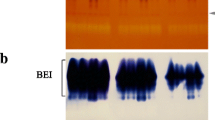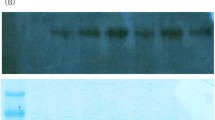Abstract
The aim of this work was to identify the starch-granule-bound starch synthase of developing pea embryos. When starch-granule-bound proteins were solubilised by digestion of granules with α-amylase and fractionated on a Mono Q anion-exchange column, activity of starch synthase eluted as three peaks. The distribution of activity in fractions from the column coincided with that of a 77-kDa protein. An antibody to this protein inhibited starch-synthase activity both in solubilised, starch-granule-bound protein and on intact starch granules. Recoveries of activity through extraction, solubilisation and chromatography indicate that this protein is the major, if not the only, form of starch synthase on the starch granule. The major, 59-kDa protein of the pea starch granule is antigenically related to the product of thewaxy locus of potato, which has previously been identified as the starch-granule-bound starch synthase of the tuber. However, the distribution of the 59-kDa protein did not coincide with that of starch-synthase activity in fractions from the Mono Q column. An antibody to the 59-kDa protein did not inhibit starch-synthase activity. The results raise questions about the relationship between “waxy” proteins and starch-granule-bound starch synthases generally.
Similar content being viewed by others
Abbreviations
- kDa:
-
kilodalton
- SDS:
-
sodium dodecyl sulphate
References
Bhattacharyya, M.K., Smith, A.M., Ellis, T.H.N., Hedley, C., Martin, C. (1990) The wrinkled-seed character of pea described by Mendel is caused by a transposon-like insertion in a gene encoding starch-branching enzyme. Cell60, 115–121
Echt, S., Schwartz, D. (1981) Evidence for the inclusion of controlling elements within the structural gene at thewaxy locus in maize. Genetics99, 275–284
Hedley, C.L., Smith, C.M., Ambrose, M.J., Cook, S., Wang, T.L. (1986) An analysis of seed development inPisum sativum. II. The effect of ther locus on the growth and development of the seed. Ann. Bot.58, 371–379
Hovenkamp-Hermelink, J.H.M., Jacobsen, E., Ponstein, A.S., Visser, R.G.F., Vos-Scheperkeuter, G.H., Bijmolt, E.W., de Vries, J.N., Witholt, B. Feenstra, W.J. (1987) Isolation of an amylose-free mutant of the potato (Solarium tuberosum L.). Theor. Appl. Genet.75, 217–221
Hseih, J.-S. (1988) Genetic studies on the Wx gene of sorghum [Sorghum bicolor (L.) Moench.] 1. Examination of the protein product of the waxy locus. Bot. Bull. Academia Sinica29, 293–299
Klösgen, R.B., Gierl, A., Schwartz-Sommer, Z., Saedler, H. (1986) Molecular analysis of thewaxy locus of maize. Mol. Gen. Genet.203, 237–244
Konishi, Y., Nojima, H., Okuno, K., Asaoka, M., Fuwa, H. (1985) Characterisation of starch granules from waxy, nonwaxy and hybrid seeds ofAmaranthus hypochrondriacus L. Agric. Biol. Chem.49, 1965–1971
Laemmli, U.K. (1970) Cleavage of structural proteins during the assembly of the head of bacteriophage T4. Nature227, 680–685
MacDonald, F.D., Preiss, J. (1983) Solubilization of the starch-granule-bound starch synthase of normal maize kernels. Plant Physiol.73, 175–178
MacDonald, F.D., Preiss, J. (1985) Partial purification and characterization of granule-bound starch synthases from normal and waxy maize. Plant Physiol.78, 849–852
Preiss, J. (1988) Biosynthesis of starch and its regulation. In: The biochemistry of plants, vol.14, pp. 181–254, Stumpf, P.K., Conn, E.E., eds. Academic Press, New York
Rohde, W., Becker, D., Salamini, F. (1988) Structural analysis of thewaxy locus fromHordeum vulgare. Nucleic Acids Res.16, 7185–7186
Sano, Y. (1984) Differential regulation ofwaxy gene expression in rice endosperm. Theor. Appl. Genet.68, 467–473
Shure, M., Wessier, S., Fedoroff, N. (1983) Molecular identification and isolation of thewaxy locus in maize. Cell35, 225–233
Smith, A.M. (1988) Major differences in isoforms of starch-branching enzyme between developing embryos of round- and wrinkled-seeded peas (Pisum sativum L.). Planta175, 270–279
Smith, A.M., Bettey, M., Bedford, I.D. (1989) Evidence that therb locus alters the starch content of developing pea embryos through an effect on ADP glucose pyrophosphorylase. Plant Physiol.89, 1279–1284
Tsai, C.-Y. (1974) The function of thewaxy locus in starch synthesis in maize endosperm. Biochem. Genet.11, 83–96
Visser, R.G.F., Hergersberg, M., Van der Leij, F.R., Jacobsen, E., Witholt, B., Feenstra, W.J. (1989) Molecular cloning and partial analysis of the gene for granule-bound starch synthase from a wildtype and an amylose-free potato (Solanum tuberosum L.). Plant Sci.64, 185–192
Vos-Scheperkeuter, G.H., Boer, W. de, Visser, R.F.G., Feenstra, W.J., Witholt, B. (1986) Identification of granule-bound starch synthase in potato tubers. Plant Physiol.82, 411–416
Author information
Authors and Affiliations
Additional information
I am grateful to my colleagues Kay Denyer, Ian Dry (CSIRO, Adelaide, Australia), Rob Ireland (Mount Allison University, New Brunswick, Canada), Cathie Martin and Steve Rawsthorne for useful discussions during the course of this work, Cliff Hedley for the gift of pea seeds, and Ian Bedford for preparing pea starch and gels of starch-granule-bound proteins. This work was supported by the Agriculture and Food Research Council via a grant-in-aid to the John Innes Institute.
Rights and permissions
About this article
Cite this article
Smith, A.M. Evidence that the “waxy” protein of pea (Pisum sativum L.) is not the major starch-granule-bound starch synthase. Planta 182, 599–604 (1990). https://doi.org/10.1007/BF02341037
Accepted:
Issue Date:
DOI: https://doi.org/10.1007/BF02341037




